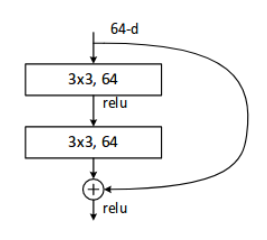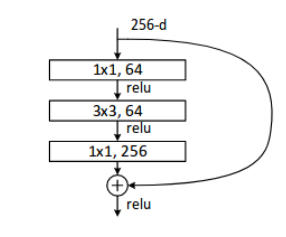ResNet34网络构建:主体结构是
# 我们这里以 ResNets34 为例子
# 先实现一个Block
class Block(nn.Module):
def __init__(self, in_channel, out_channel, strides=1, same_shape=True):
super(Block, self).__init__()
self.same_shape = same_shape
if not same_shape:
strides = 2
self.strides = strides
self.block = nn.Sequential(
nn.Conv2d(in_channel, out_channel, kernel_size=3, stride=strides, padding=1, bias=False),
nn.BatchNorm2d(out_channel),
nn.ReLU(inplace=True),
nn.Conv2d(out_channel, out_channel, kernel_size=3, padding=1, bias=False),
nn.BatchNorm2d(out_channel)
)
if not same_shape:
self.conv3 = nn.Conv2d(in_channel, out_channel, kernel_size=1, stride=strides, bias=False)
self.bn3 = nn.BatchNorm2d(out_channel)
def forward(self, x):
out = self.block(x)
if not self.same_shape:
x = self.bn3(self.conv3(x))
return F.relu(out + x)
# 开始实现 ResNets34
class ResNet34(nn.Module):
def __init__(self, num_classes=10):
super(ResNet34, self).__init__()
# 最开始的几层
self.pre = nn.Sequential(
nn.Conv2d(3, 64, 7, 2, 3, bias=False),
nn.BatchNorm2d(64),
nn.ReLU(inplace=True),
nn.MaxPool2d(3, 2, 1))
# 从论文的图中,可以看到,我们有3,4,6,3个block
self.layer1 = self._make_layer(64, 64, 3)
self.layer2 = self._make_layer(64, 128, 4, stride=2)
self.layer3 = self._make_layer(128, 256, 6, stride=2)
self.layer4 = self._make_layer(256, 512, 3, stride=2)
# 分类用的全连接
self.fc = nn.Linear(512, num_classes)
def _make_layer(self, in_channel, out_channel, block_num, stride=1):
layers = []
if stride != 1:
layers.append(Block(in_channel, out_channel, stride, same_shape=False))
else:
layers.append(Block(in_channel, out_channel, stride))
for i in range(1, block_num):
layers.append(Block(out_channel, out_channel))
return nn.Sequential(*layers)
# 在jupyter notebook中,可以尝试输出每一层的size,来查看每一层的输入、输出是否正确。
def forward(self, x):
x = self.pre(x)
x = self.layer1(x)
x = self.layer2(x)
x = self.layer3(x)
x = self.layer4(x)
x = F.avg_pool2d(x, 7)
x = x.view(x.size(0), -1)
return self.fc(x)
ResNet-50/101/152网络构建:主体结构是
# 先实现一个Block
class Bottleneck(nn.Module):
def __init__(self, in_channel, out_channel, strides=1, same_shape=True, bottle=True):
super(Bottleneck, self).__init__()
self.same_shape = same_shape
self.bottle = bottle
if not same_shape:
strides = 2
self.strides = strides
self.block = nn.Sequential(
nn.Conv2d(in_channel, out_channel, kernel_size=1, bias=False),
nn.BatchNorm2d(out_channel),
nn.ReLU(inplace=True),
nn.Conv2d(out_channel, out_channel, kernel_size=3, stride=strides, padding=1, bias=False),
nn.BatchNorm2d(out_channel),
nn.Conv2d(out_channel, out_channel*4, kernel_size=1, bias=False),
nn.BatchNorm2d(out_channel*4)
)
if not same_shape or not bottle:
self.conv4 = nn.Conv2d(in_channel, out_channel*4, kernel_size=1, stride=strides, bias=False)
self.bn4 = nn.BatchNorm2d(out_channel*4)
print(self.conv4)
def forward(self, x):
print(x.size())
out = self.block(x)
print(out.size())
if not self.same_shape or not self.bottle:
x = self.bn4(self.conv4(x))
return F.relu(out + x)





















 3万+
3万+











 被折叠的 条评论
为什么被折叠?
被折叠的 条评论
为什么被折叠?








